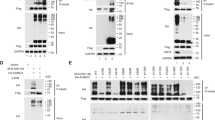Abstract
SUMOylation and deSUMOylation are dynamic mechanisms regulating a spectrum of protein activities. The SUMO proteases (SENP) remove SUMO conjugate from proteins, and their expression is deregulated in cancers. SENP2 has been reported to play a critical role in the control of hepatocellular carcinoma (HCC) cell growth by modulating the stability of β-catenin. However, the underlying mechanism remains largely unknown. Here, we show that the WW domain-containing oxidoreductase (WWOX), a novel inhibitor of the Wnt/β-catenin pathway, is required for stabilization of β-catenin regulated by SENP2 in HCC cells. The transcriptional level of WWOX is tightly regulated by SENP2. Moreover, knockdown of WWOX by siRNA attuned SENP2-induced β-catenin degradation and decreased SENP2-mediated HCC cell proliferation arrest. Taken together, our data suggested that WWOX is a key downstream modulator of the SENP2 tumor suppressor function in HCC cell.




Similar content being viewed by others
References
Jemal A, Bray F, Center MM, Ferlay J, Ward E, Forman D. Global cancer statistics. CA Cancer J Clin. 2011;61:69–90.
Maluccio M, Covey A. Recent progress in understanding, diagnosing, and treating hepatocellular carcinoma. CA: Cancer J Clin. 2012;62:394–9.
Geiss-Friedlander R, Melchior F. Concepts in sumoylation: a decade on. Nat Rev Mol Cell Biol. 2007;8:947–56.
Wilkinson KA, Henley JM. Mechanisms, regulation and consequences of protein sumoylation. Biochem J. 2010;428:133–45.
Sarge KD, Park-Sarge OK. Sumo and its role in human diseases. Int Rev Cell Mol Biol. 2011;288:167–83.
Hwang KW, Won TJ, Kim H, Chun HJ, Chun T, Park Y. Characterization of the regulatory roles of the sumo. Diabetes Metab Res Rev. 2011;27:854–61.
Wei W, Yang P, Pang J, Zhang S, Wang Y, Wang MH, et al. A stress-dependent sumo4 sumoylation of its substrate proteins. Biochem Biophys Res Commun. 2008;375:454–9.
Wang CY, Podolsky R, She JX. Genetic and functional evidence supporting sumo4 as a type 1 diabetes susceptibility gene. Ann N Y Acad Sci. 2006;1079:257–67.
Hannoun Z, Greenhough S, Jaffray E, Hay RT, Hay DC. Post-translational modification by sumo. Toxicology. 2010;278:288–93.
Bawa-Khalfe T, Yeh ET. Sumo losing balance: sumo proteases disrupt sumo homeostasis to facilitate cancer development and progression. Genes Cancer. 2010;1:748–52.
Yeh ET. Sumoylation and de-sumoylation: wrestling with life’s processes. J Biol Chem. 2009;284:8223–7.
Kim JH, Baek SH. Emerging roles of desumoylating enzymes. Biochim Biophys Acta. 2009;1792:155–62.
Jiang M, Chiu SY, Hsu W. Sumo-specific protease 2 in mdm2-mediated regulation of p53. Cell Death Differ. 2011;18:1005–15.
Chiu SY, Asai N, Costantini F, Hsu W. Sumo-specific protease 2 is essential for modulating p53-mdm2 in development of trophoblast stem cell niches and lineages. PLoS Biol. 2008;6:e310.
Zhang XD, Goeres J, Zhang H, Yen TJ, Porter AC, Matunis MJ. Sumo −2/3 modification and binding regulate the association of cenp-e with kinetochores and progression through mitosis. Mol Cell. 2008;29:729–41.
Schweizer N, Ferras C, Kern DM, Logarinho E, Cheeseman IM, Maiato H. Spindle assembly checkpoint robustness requires tpr-mediated regulation of mad1/mad2 proteostasis. J Cell Biol. 2013;203:883–93.
Cubenas-Potts C, Goeres JD, Matunis MJ. Senp1 and Senp2 affect spatial and temporal control of sumoylation in mitosis. Mol Biol Cell. 2013;24:3483–95.
Lu H, Liu B, You S, Chen L, Dongmei Q, Gu M, Lu Y, Chen Y, Zhang F, Yu B: Senp2 regulates mef2a de-sumoylation in an activity dependent manner. Mol Biol Rep. 2012
Kang X, Qi Y, Zuo Y, Wang Q, Zou Y, Schwartz RJ, et al. Sumo-specific protease 2 is essential for suppression of polycomb group protein-mediated gene silencing during embryonic development. Mol Cell. 2010;38:191–201.
Shen HJ, Zhu HY, Yang C, Ji F. Senp2 regulates hepatocellular carcinoma cell growth by modulating the stability of beta-catenin. Asian Pac J Cancer Prev: APJCP. 2012;13:3583–7.
Tan MY, Mu XY, Liu B, Wang Y, Bao ED, Qiu JX, et al. Sumo-specific protease 2 suppresses cell migration and invasion through inhibiting the expression of mmp13 in bladder cancer cells. Cel Physiol Biochem: Int J Exp Cel Physiol, Biochem, Pharmacol. 2013;32:542–8.
Nait Achour T, Sentis S, Teyssier C, Philippat A, Lucas A, Corbo L, et al. Transcriptional repression of estrogen receptor alpha signaling by Senp2 in breast cancer cells. Mol Endocrinol (Baltim, Md). 2014;28:183–96.
Bouteille N, Driouch K, Hage PE, Sin S, Formstecher E, Camonis J, et al. Inhibition of the Wnt/beta-catenin pathway by the WWOX tumor suppressor protein. Oncogene. 2009;28:2569–80.
Li YP, Wu CC, Chen WT, Huang YC, Chai CY. The expression and significance of WWOX and beta-catenin in hepatocellular carcinoma. APMIS: Acta Pathol, Microbiol, Immunol Scand. 2013;121:120–6.
Klaus A, Birchmeier W. Wnt signalling and its impact on development and cancer. Nat Rev Cancer. 2008;8:387–98.
Del Mare S, Kurek KC, Stein GS, Lian JB, Aqeilan RI. Role of the WWOX tumor suppressor gene in bone homeostasis and the pathogenesis of osteosarcoma. Am J Cancer Res. 2011;1:585–94.
Hezova R, Ehrmann J, Kolar Z. WWOX, a new potential tumor suppressor gene. Biomed Pap Med Fac Univ Palacky, Olomouc, Czechoslov. 2007;151:11–5.
Abdeen SK, Del Mare S, Hussain S, Remaileh MA, Salah Z, Hagan J, Rawahneh M, Pu XA, Russell S, Stein JL, Stein GS, Lian JB, Aqeilan RI: Conditional inactivation of the mouse wwox tumor suppressor gene recapitulates the null phenotype. J Cell Physiol. 2012
Aqeilan RI, Trapasso F, Hussain S, Costinean S, Marshall D, Pekarsky Y, et al. Targeted deletion of WWOX reveals a tumor suppressor function. Proc Natl Acad Sci USA. 2007;104:3949–54.
Conflicts of interest
None
Author information
Authors and Affiliations
Corresponding author
Rights and permissions
About this article
Cite this article
Jiang, QF., Tian, YW., Shen, Q. et al. SENP2 regulated the stability of β-catenin through WWOX in hepatocellular carcinoma cell. Tumor Biol. 35, 9677–9682 (2014). https://doi.org/10.1007/s13277-014-2239-8
Received:
Accepted:
Published:
Issue Date:
DOI: https://doi.org/10.1007/s13277-014-2239-8




